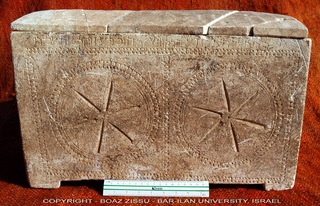Three years ago the Israel Antiquities Authority Unit for the Prevention of Antiquities Robbery acquired a decorated ossuary bearing an engraved inscription. The ossuary was discovered by antiquities robbers who plundered an ancient Jewish tomb of the Second Temple period. During the course of the investigation it was determined that the ossuary came from a burial cave in the area of the Valley of ’Elah, in the Judean Shephelah.

To check the authenticity of the artifact and the significance of the engraved inscription, the Israel Antiquities Authority turned to Dr. Boaz Zissu of the Department of the Land of Israel Studies and Archaeology of Bar Ilan University and Professor Yuval Goren of the Department of Archaeology and Ancient Near Eastern Civilizations of the Tel Aviv University.
The two scientists published the results of their research, which summarize the importance of the find and confirm its genuineness. The study appears in the Israel Exploration Journal (Volume 61) published by the Israel Exploration Society.
Ossuaries are small stone chests that Jews used for secondary burial of bones; they were quite common in tombs in Israel from the late first century BCE until the beginning of the second century CE. The front of the ossuary that was found is decorated with a stylized floral motif above which is a long Aramaic inscription engraved in Jewish script:
‘Miriam Daughter of Yeshua Son of Caiaphas, Priests [of] Ma'aziah from Beth ’Imri’
(or, an alternative reading:
‘Miriam Daughter of Yeshua Son of Caiaphas, Priest of Ma'aziah from Beth ’Imri’)
In the conclusion of their study Dr. Boaz Zissu and Professor Yuval Goren write, “the prime importance of the inscription lies in the reference to the ancestry of the deceased – Miriam daughter of Yeshua – to the Caiaphas family, indicating the connection to the family of the Ma'aziah course of priests of Beth ’Imri”. Caiaphas is the name of Yeshua’s father, and Miriam‘s grandfather. From the wording of the inscription we learn that he belonged to a famous family of priests that was active in the first century CE. One family member, the high priest Yehosef Bar Caiaphas, is especially famous for his involvement in the trial and crucifixion of Jesus.
Ma'aziah /Ma'aziahu is the last of the twenty four priestly courses that served in the Temple in Jerusalem. The list of courses, which was formulated during King David’s reign, appears in the Bible in I Chronicles (I Chronicles 24:18). The signatories to the pledge in the days of Nehemiah include among others, “Maʽaziah, Bilgai, Shem'aiah; these are the priests” (Nehemiah 10: 9). This is the first reference to the Maʽaziah course in an epigraphic find from the Second Temple period. For the first time we learn from an inscription that the Caiaphas family was related to the Ma'aziah course.
The names of other courses, such as Abijah, Eliashib, Bilgah, Delaiah, Hakkoz, Shecaniah, Hezir, Jehoiarib, Jakim (Jakin) and Jeshebeab, are known from historical and epigraphic texts from the Second Temple period, including inscriptions discovered in tombs.
The ending “from Beth ’Imri” can be interpreted two ways:
The first possibility is that Beth ’Imri is the name of a priestly family – the sons of ’Immer (Ezra 2: 36-37; Nehemiah 7:39-42) whose descendents include members of the Maʽaziah course.
The second possibility is the place of origin of the deceased or of her entire family.The name of the ancient settlement was probably preserved in the name Beit ’Ummar, a village in the northern Hebron Hills. In that village and in nearby Khirbet Kufin, remains of a Jewish settlement were identified from the Second Temple period and the time of the Bar Kokhba Revolt.
In view of the inscription on the ossuary it is worth examining the linguistic relationship between the names Caiaphas – a prominent family that seems to have lived in Beth ’Imri/ Beit ’Ummar – and Khirbet Kufin, which perhaps preserves the name of the Caiaphas family.
Since the ossuary in question was not found in a controlled archaeological excavation and because of its special scientific importance, it was subjected to microscopic examinations using an environmental scanning electron microscope/energy dispersive spectrometer (ESEM/EDS), the purpose of which was to evaluate its authenticity.The patina covering the sides was checked, with emphasis on the patina covering the inscription. The examinations determined that the inscription is genuine and ancient.
The Israel Antiquities Authority is distressed by the fact that this important find, which was plundered from its original provenance, was removed from its archeological context, thus it will never be possible to know the full story of the burial cave. Sadly, the robbers’ desire of monetary gain has erased entire pages of the country’s cultural history.
No comments:
Post a Comment